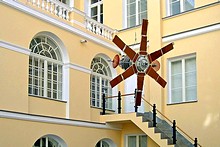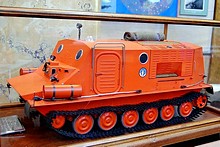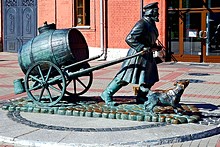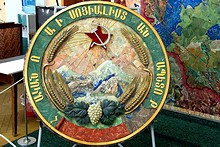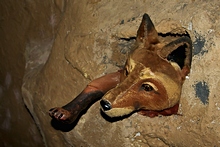Museums of Science and Technology
St. Petersburg is not only Russia's cultural capital, it also a major industrial center with some of the finest universities and research institutes in the country. Peter the Great, the city's founder, was himself fascinated by engineering, technology, and all branches of science, and founded the first 'scientific' museum in the city, the bizarrely fascinating Kunstkammer. Nowadays, St. Petersburg has a wealth of museums dedicated to a wide range of scientific and technological disciplines, many of which are well worth checking out.
The Kunstkammer was the first state museum of history and the natural sciences in Russia. Its original collection became the basis for eight separate academic museums, including the Museum of Anthropology and Ethnography, which the building now houses.
Next to the State Russian Museum, this superb collection charts the history of all the different ethnicities of the Soviet Union and the Russian Empire, from shamanistic tribes in Siberia to the Finno-Ugraic peoples of the Russian north.
One of the most popular visitor attractions in St. Petersburg for children and families, this massive interactive model of Russia is a marvel of craftsmanship and imagination, compressing the world's biggest country and its people into a fun and fascinating display.
Located in a former palace near St. Isaac's Cathedral, this historic museum has a vast collection devoted to the development of modern communications technology, including lots of antique post and telecom equipment and a huge collection of stamps.
Devoted to the history of Russian and Soviet polar exploration, this centrally located museum is traditional in style, but has a huge number of unique exhibits, including ethnographical materials on the people's of the polar regions, and lots of historic equipment from polar expeditions.
Located right next to the Peter and Paul Fortress, this historic museum features a wealth of military hardware, making it perennially popular with children. The second floor of the museum is devoted to memorabilia from the Second World War.
In the walls of the Peter and Paul Fortress, in a space that was used for groundbreaking rocket research in the 1930s, this small but captivating museum charts the history of Soviet and Russian rocket technology and space exploration.
Containing a huge number of documents and models that tell the story of Russian and Soviet railways from the first Russian steam-train to conceptual "bullet" trains that are still in the pipeline, this is Russia's finest and largest railway museum.
Saint Petersburg's Museum of Hygiene is the only one of its kind in Russia, with a collection of approximately 11,000 exhibits collected from public demonstrations about hygiene in Russia and abroad in the 19th and 20th Centuries.
This historic ship, moored off the embankment of Vasilievsky Island, was one of the longest serving in the Soviet Navy, particularly revered for its role in the Arctic Convoys of the Second World War. Visitors can walk over the ship and examine its equipment.
The city's first water tower has been transformed into a hi-tech museum that examines every aspect of water provision, historically and in the present day, with a series of exciting interactive exhibits.
St. Petersburg's Zoological Museum is a classic of its kind, with over 40,000 exhibits including a mammoth skeleton, stuffed animals from all over the world, and a particularly fine collection of Lepidoptera.
A fun, family-friendly small museum near the Church on the Spilled Blood, with working examples of dozens of Soviet-era arcade games. Popular with nostalgic locals as well as vintage-obssessed visitors, the museum makes for a great half-hour break during more serious sightseeing.
This small museum is devoted to the history of bread in St. Petersburg, with displays detailing traditional Russian baking practices and bread-making in different periods, as well as a large quantity of historic packaging and advertising materials.
There are beer museums in a number of the world's major cities. Saint Petersburg's has the advantage of being located in the Stepan Razin Brewery, the oldest in Russia. Beer enthusiasts can learn about the history of brewing in Russia and, of course, sample the factory's products.
Small museum in a beautiful building on the Moika River, tracing the history of printing in St. Petersburg from the start of the 19th century. On display are antique printing presses and a wealth of printed material.
St. Petersburg's newest "floating museum", this Soviet-era submarine was rescued from the seabed in 2005. Now it is docked next to Lieutenant Schmidt Bridge and is open to the public for tours, guided by former submariners.
Part of a shopping centre in downtown St. Petersburg, Russia's first Oceanarium has nearly 150 species of sea creature on display in its aquariums, as well as free shows featuring sharks and seals, a diving centre, and various activities for children.
On the road to Pulkovo Airport, this museum charts the history of aviation in Russia, with displays including a large number of plane parts and instruments, as well as the insignia and flags of different airlines.
Part of the Eastern European Institute of Psychoanalysis, this small and unusual museum seeks to immerse visitors in Dr. Freud's revelatory vision of the subconscious using installations featuring text, images, and audio recordings.
This museum in the impressive building of the All-Russian Geological Institute has a rich collection covering all aspects of geology (including paleontology), and pride of place goes to a map of the USSR made entirely of semi-precious stones.
Part of St. Petersburg State University's Mineralogy Department in the Twelve Colleges building, this collection dates back to 1783 and comprises a systematic display of Russia's mineral wealth, including precious stones and meteorites.
Housed in the beautiful marble halls of one of Russia's premier engineering colleges, this old-fashioned museum contains historic mining equipment and a wealth of mineral samples, many dating back to the reign of Catherine the Great.
This highly educational museum, honoring one of Russia's greatest Victorian-era scientists, has a prime location next to the Stock Exchange, and contains some fascinating displays, as well as plenty of interactive materials for children.
Located at the old Vasilevskiy Island tram depot, which dates back to 1908, this museum's collection comprises over sixty historic trams and trolleybuses, most of which are still in working order, as well as a large collection of models and archive material.
St. Petersburg's Planetarium is extremely popular with young children, and although its collection is not the most up-to-date, it does have some interesting exhibits, especially the interactive Laboratory of Intriguing Experiments.
A beautiful 19th century building close to St. Petersburg's airport, Pulkovo Observatory is one of Russia's main astronomical institutions, and also contains a collection of historic instruments from the 18th and 19th centuries.
This large and sporadically interesting collection covers both military medicine and the general development of medicine in Russia and throughout the world. Among the more interesting exhibits are Soviet public health materials.
Attached to a restaurant, this museum is more enjoyable than educational, with the vodka tasting at the end of the tour the main attraction. Nonetheless, it has a reasonably extensive collection of vodka-related paraphernalia.
Located on the tracks behind the building of the Baltiyskiy Station, this museum has a number of historic Soviet and Russian steam engines and rolling stock, including Second World War rail armaments.




